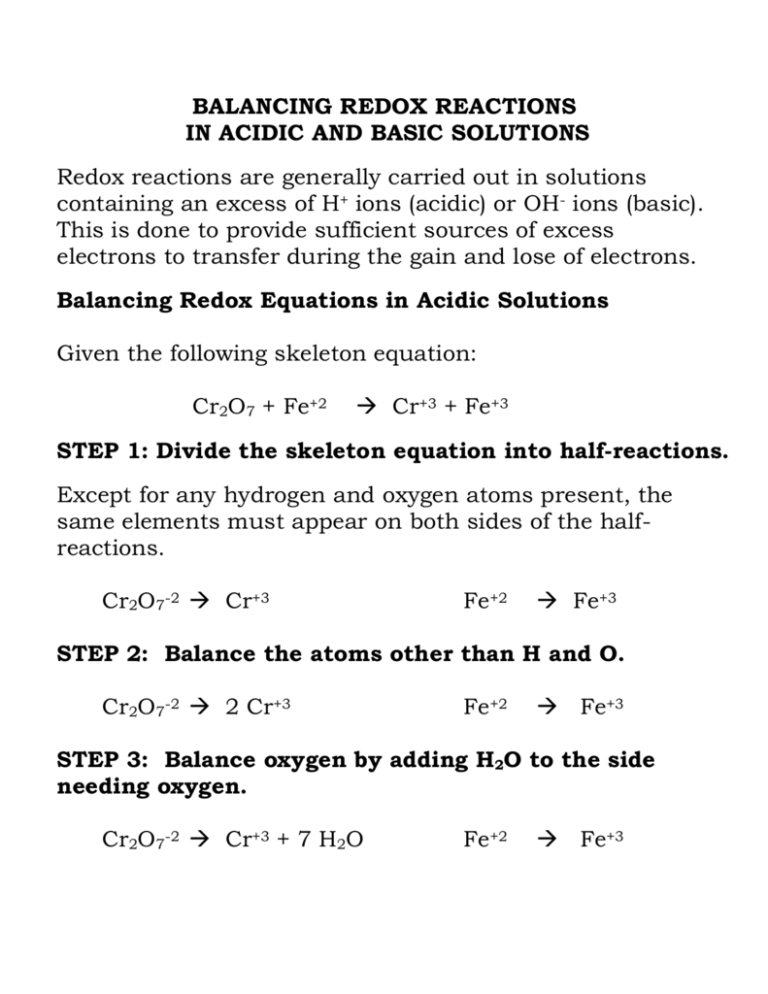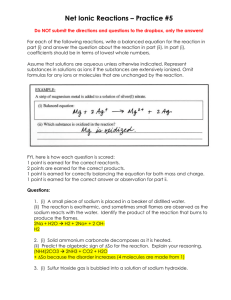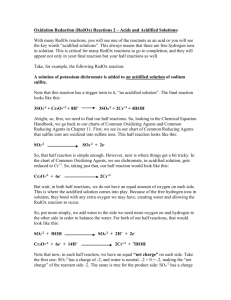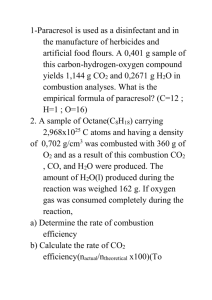Balancing Redox Reactions: Acidic & Basic Solutions Guide
advertisement

BALANCING REDOX REACTIONS IN ACIDIC AND BASIC SOLUTIONS Redox reactions are generally carried out in solutions containing an excess of H+ ions (acidic) or OH- ions (basic). This is done to provide sufficient sources of excess electrons to transfer during the gain and lose of electrons. Balancing Redox Equations in Acidic Solutions Given the following skeleton equation: Cr2O7 + Fe+2 Cr+3 + Fe+3 STEP 1: Divide the skeleton equation into half-reactions. Except for any hydrogen and oxygen atoms present, the same elements must appear on both sides of the halfreactions. Cr2O7-2 Cr+3 Fe+2 Fe+3 STEP 2: Balance the atoms other than H and O. Cr2O7-2 2 Cr+3 Fe+2 Fe+3 STEP 3: Balance oxygen by adding H2O to the side needing oxygen. Cr2O7-2 Cr+3 + 7 H2O Fe+2 Fe+3 STEP 4: Balance hydrogen by adding H+ to the side needing hydrogen. 14 H+ + Cr2O7-2 Cr+3 + 7 H2O Fe+2 Fe+3 STEP 5: Balance the charge by finding the electrons gained and lost by the oxidizing and reducing agents. First compute the net charge on each side of the reaction: 14 H+ + Cr2O7-2 2 Cr+3 + 7 H2O (+14) + (-2) = +12 2(+3) + 0 = +6 Fe+2 Fe+3 +2 +3 Then balance using electrons: 14 H+ + Cr2O7-2 + 6 e- 2 Cr+3 + 7 H2O Fe+2 – 1 e- Fe+3 (+14) + (-2) + (-6) = +6 (+2)–(-1)=+3 +3 2(+3) + 0 = +6 STEP 6: Use coefficients to multiply the half-reactions so that the number of electrons gained is equal to the number of electrons lost. 1 x (14 H+ + Cr2O7-2 + 6 e- 2 Cr+3 + 7 H2O) 6 x (Fe+2 – 1 e- Fe+3) = = 14 H+ + Cr2O7-2 + 6 e- 2 Cr+3 + 7 H2O 6 Fe+2 – 6 e- 6 Fe+3 STEP 7: Add the half-reactions together. (Cancel anything that appears on both sides of the equation.) 14 H+ + Cr2O7-2 + 6 e- 2 Cr+3 + 7 H2O 6 Fe+2 – 6 e- 6 Fe+3 14 H+ + Cr2O7-2 + 6 Fe+2 6 Fe+3 + 2 Cr+3 + 7 H2O PRACTICE PROBLEMS: Balance the following redox reactions occuring in acidic solution. 1. SO4-2 + Zn Zn+2 + SO2 2. Cu + NO3-1 Cu+2 + NO 3. S2O3-2 + OCl-1 Cl-1 + S4O6-2 4. IO3-1 + AsO3-3 I-1 + AsO4-3 5. Mn+2 + BiO3-1 MnO4-1 + Bi+3 6. PbO2 + Cl-1 PbCl2 + Cl2 7. Ag + NO3-1 NO2 + Ag+1 8. Cr+3 + BiO-1 Cr2O7-2 + Bi+3 9. HNO2 + I-1 I2 + NO 10. C2O4-2 + HNO2 CO2 + NO Balancing Redox Equations in Basic Solutions In basic solutions the H+ concentration is very small. The dominant species are OH- and H2O. Strictly speaking, these should be used to balance the half reactions. However, the simplest way to obtain a balanced equation is to first pretend that the solution is acidic. We therefore balance the equation using the seven steps described above, and then we use a simple three-step procedure to convert the equation to the correct form for a basic solution. Example: SO3-2 + MnO4-1 SO4-2 + MnO2 (Basic) After following the seven steps above for acidic solutions the equation would be: 2 H+1 + 3 SO3-2 + 2 MnO4-1 3 SO4-2 + 2 MnO2 + H2O Conversion of this equation to one appropriate for a basic solution uses the fact that H+ and OH- react in a 1:1 ratio to give H2O. The following steps show this: STEP 8: Add the same number of H+ as there are OHto BOTH sides of the equation. 2 OH- + 2 H+1 + 3SO3-2 + 2MnO4-1 3SO4-2 + 2MnO2 + H2O + 2 OH- STEP 9: Combine H+ and OH- to form H2O. 2 H2O + 3 SO3-2 + 2 MnO4-1 3 SO4-2 + 2 MnO2 + H2O + 2 OHSTEP 10: Cancel any H2O that appears on both sides of the equation. H2O + 3 SO3-2 + 2 MnO4-1 3 SO4-2 + 2 MnO2 + 2 OH- PRACTICE PROBLEMS: Balance the following redox reactions occuring in basic solution. 1. CrO4-2 + S-2 S + CrO2-1 2. ClO3-1 + N2H4 NO + Cl-1 3. NiO2 + Mn(OH)2 Mn2O3 + Ni(OH)2 4. SO3-2 + MnO4-1 SO4-2 + MnO2 5. CrO2-1 + S2O8-2 CrO4 + SO4-2 6. Au + CN-1 + O2 Au(CN)4 + OH-1








